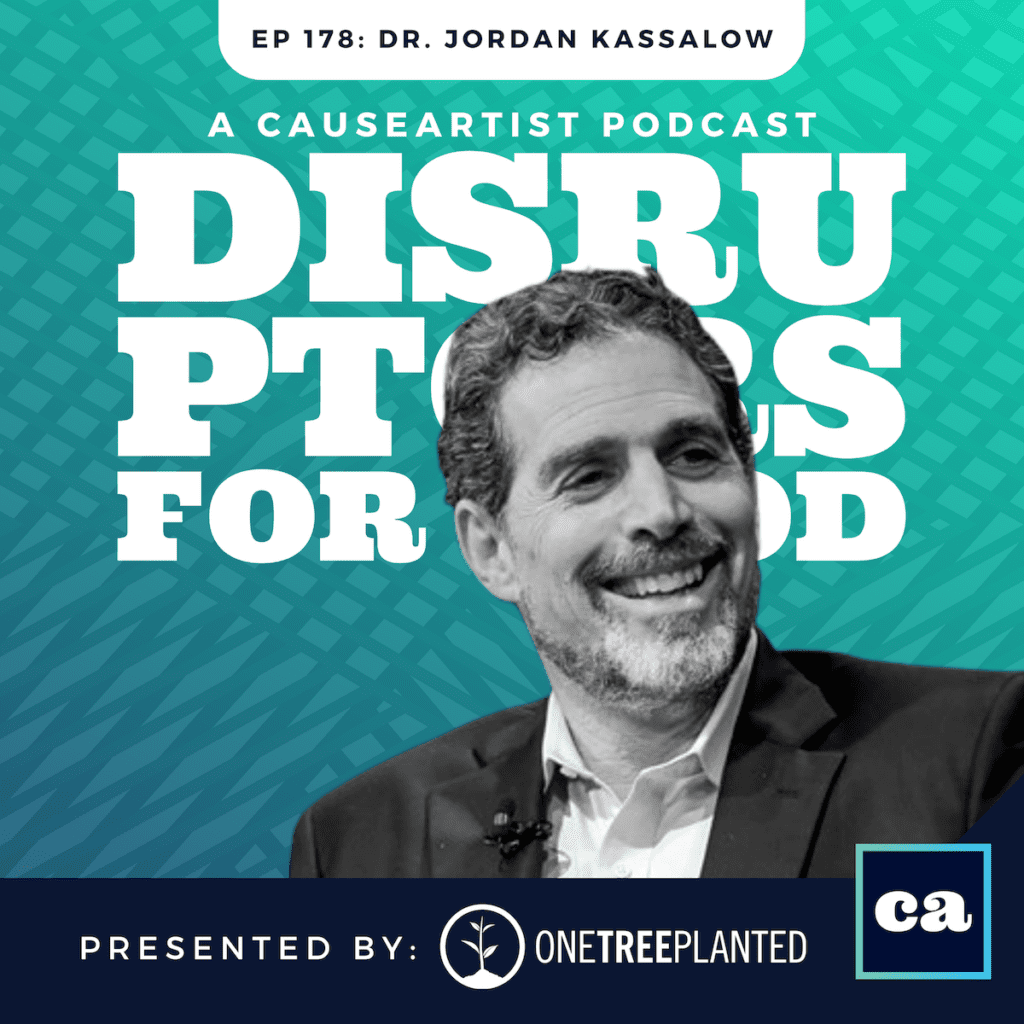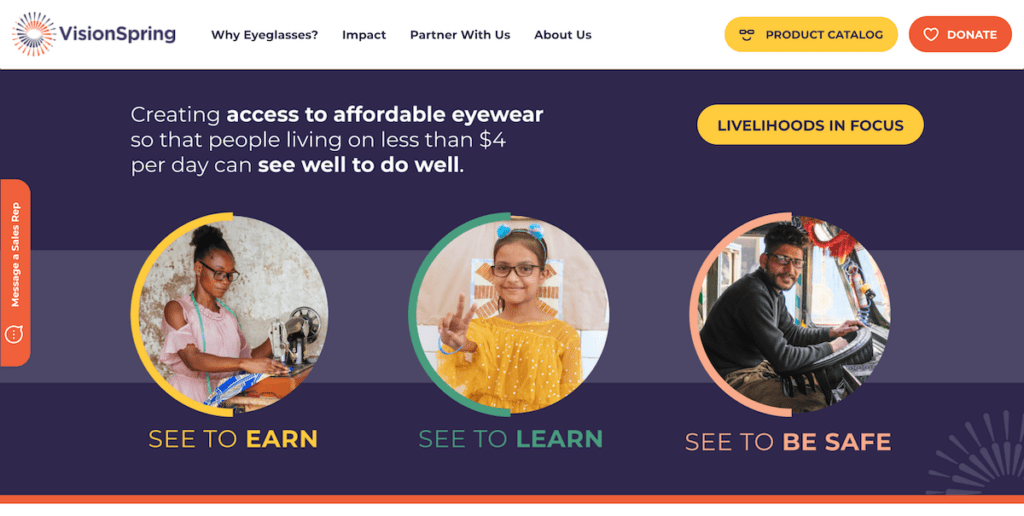In episode 178 of the Disruptors for GOOD podcast, I speak with Dr. Jordan Kassalow, founder of VisionSpring, on his journey to bring millions of people around the world access to eyecare.
Listen to more Causeartist podcasts.
About Dr. Jordan Kassalow
Dr. Jordan Kassalow has an amazing career in social entrepreneurship and eye care advocacy. He co-founded EYElliance, a coalition working towards improving access to eyeglasses globally, and launched the Global Health Policy Program at the Council on Foreign Relations.
Prior to this, he served as director of the River Blindness Division at Helen Keller International.
Jordan is a fellow of Draper Richards Kaplan, Skoll, Ashoka, and the Aspen Institute. He has received numerous awards for his contributions to social entrepreneurship, including being named to Forbes’ Impact 30 list, winning the inaugural John P. McNulty Prize, and receiving the Schwab Foundation Social Entrepreneurship award.

In addition to his social entrepreneurship work, Jordan is a partner at Drs. Farkas, Kassalow, Resnick & Associates, an ophthalmology practice located in New York City.
Jordan holds a Doctor of Optometry degree from the New England College of Optometry and a Master of Public Health degree and fellowship in preventive ophthalmology from Johns Hopkins University.
About VisionSpring
Imagine not being able to see clearly enough to read a book, drive a car, or even recognize the faces of your loved ones. For millions of people living in underserved communities around the world, this is a reality.
Poor vision not only affects a person’s daily activities but can also impact their ability to work and support themselves and their families.
This is where VisionSpring comes in. VisionSpring is a nonprofit organization that aims to increase access to affordable eyewear and eye care services for people living in low-income communities.

In addition to providing eyewear, VisionSpring also conducts research and advocates for policies that promote vision health and increase access to eyewear and eye care services.
The organization has partnered with governments, nonprofits, and businesses to implement vision screening programs and provide eyeglasses to schoolchildren, improving their academic performance and future opportunities.
VisionSpring’s impact goes beyond providing eyewear and eye care services. By empowering local entrepreneurs and advocating for better vision health policies, the organization is contributing to sustainable development and poverty reduction in low-income communities.
With its innovative approach and unwavering commitment to its mission, VisionSpring is making a difference in the lives of millions of people around the world.
If you’re interested in supporting VisionSpring’s mission, there are several ways you can get involved. You can make a donation on their website, volunteer your time and skills, or even start your own fundraising campaign.
With your support, VisionSpring can continue to bring sight to the underserved and improve the lives of millions of people.
Interview Transcript
00:09
Host: Well, thank you so much, Dr. Kay, for joining me today. Super excited to talk about your journey in starting Vision Spring and all it’s doing for the world. You know, eye care is essential, and in the developed world, it’s relatively easy to get what we need. Before we get into what Vision Spring is doing globally, talk about your journey to get to that point. What was the catalyst and inspiration to start Vision Spring?
00:40
Dr. Kay: Thanks, Grant. Thanks for having me on the podcast. The journey was a relatively long one. It started almost 40 years ago when I was in my early 20s. Now I’m in my early 60s. The way I think about it is that there are three components to the journey. One is finding my purpose and meaning, two is finding my calling, and three is how to put that calling into the world and execute it.
My purpose and meaning journey started when I was 23. I spent most of my free time as a mountaineer, climbing mountains all over the world. I was in the northern part of Alaska in the Brooks Range, climbing a mountain on a nasty day.
At the top, I had an existential moment where I felt both nothing and everything at the same time. The world told me I was insignificant but also part of a greater whole. That moment drove me to want a professional life with purpose and meaning.
01:40
Fast forward six months, I enrolled in optometry school to become an eye doctor. Initially, I was kind of depressed because the idea of being in a dark room without windows for the rest of my life was daunting. A few months into school, a group called VOSH (Volunteer Optometric Services to Humanity) came to talk to us about bringing eye care to underserved people worldwide.
That resonated with me, and I went on a trip to rural Mexico. There was a line of 2000 people around our temporary clinic, and my first patient was a seven-year-old boy from a school for the blind. He wasn’t blind; he just needed a really strong pair of glasses. I found a pair that matched his prescription and changed both of our lives. That moment gave me my vision and calling.
03:20
In my book, “Dare to Matter,” I talk about walking through the world with a prepared heart. If you’re looking for a life of purpose and meaning, you have to be open to it. That moment in Mexico struck me like a lightning bolt. From there, it was a 17-year journey to founding Vision Spring. But before I continue, I’ll pause to make sure I’m not just talking at you.
06:02
Host: That was going to be my next question. After you have that remarkable moment, what do you do next? What were those actions right after that?
06:55
Dr. Kay: That’s where the rubber hits the road. Finding your calling gives you a North Star. I realized the organization I was with wasn’t the best model. I found out about the Aravind Eye Hospital in India, founded by Dr. Venkataswamy, a social entrepreneur who mastered providing cataract surgery at scale.
I spent a year learning from him about compassionate capitalism and cross-subsidization, charging those who can pay to subsidize those who can’t. He challenged me to do for glasses what he did for cataract surgery, but I wasn’t ready yet. Fear held me back, and the issue of uncorrected vision wasn’t on the global public health radar. So, I focused on where the action was—river blindness.
10:54
My work in river blindness taught me about distributing health products and services to people at the end of the road. I led Helen Keller’s river blindness program for eight years, learning about distribution and sustainability. Then, I moved on to understanding policy and power at the Council on Foreign Relations, convincing leaders that health issues are national security and economic development issues. This was crucial for understanding how to interject health issues onto global agendas.
16:04
Eventually, I returned to the eyeglass world and started a business called Scojo, which had a nonprofit arm, the Scojo Foundation. We created fashionable, affordable reading glasses for the US market and used 5% of the profits to fund our Vision Entrepreneur program, training women to sell eyeglasses in their communities. Neil Blumenthal, co-founder of Warby Parker, was my second employee at Scojo Foundation. We sold Scojo, rebranded the foundation as Vision Spring, and continued our mission.
18:10
Host: Did Neil leave to start Warby Parker, and how did that relationship evolve?
18:10
Dr. Kay: Neil went to business school, where he met his Warby Parker co-founders. They saw the opportunity to make glasses affordable and fashionable. Vision Spring was a natural conduit for Warby’s one-for-one model. For every pair they sell, they donate money to Vision Spring to distribute glasses appropriate for our markets. About 80% of their donations still go through Vision Spring.
20:34
Host: What is Vision Spring’s mission, and how do you explain it to people?
20:54
Dr. Kay: Our mission is to increase lifelong earning, learning, safety, and well-being through eyeglasses for people vulnerable to poverty. We have two main arms: our B2B program, providing a high-quality supply chain of glasses to institutions like hospitals, and our B2C Vision Access programs, which include See to Earn, See to Learn, and See to Be Safe. See to Earn focuses on providing glasses to workers to improve productivity. See to Learn ensures children can see to learn better. See to Be Safe helps drivers and transportation workers see clearly, enhancing safety.
24:22
Host: Can you talk about the scope of the vision impairment issue globally?
25:05
Dr. Kay: Eyeglasses, despite being invented over 700 years ago, are still not accessible to many. One billion people are visually impaired or blind due to lack of glasses, making it the largest disability in the world. Studies show that providing glasses increases productivity significantly. For instance, our Prosper study in India showed a 22% productivity increase in tea pickers who received glasses.
27:23
Host: How has this issue progressed from a policy standpoint?
27:23
Dr. Kay: We’ve produced research showing the economic benefits of providing glasses. This has helped us engage with ministries of finance, health, and education. I co-founded an organization called EYElliance, which brings together stakeholders to advocate for vision care. The World Health Organization and other major institutions are starting to recognize and support this issue, but there’s still a long way to go.
31:05
Host: How do you scale the solution when prescriptions are so individualized?
32:21
Dr. Kay: The majority of people need ready-made reading glasses, which have only a few prescriptions. For prescription glasses, we’ve developed pop-in glasses that cover most needs with a couple dozen prescriptions. This approach allows us to meet the needs of over 90% of people.
35:11
Host: What inspires you about the next decade, and what are Vision Spring’s goals?
35:33
Dr. Kay: It’s important for an entrepreneur to know their strengths. My strength was identifying the problem and building the foundation. Our CEO, Ella Goodwin, is a builder. We have a strong team and strategy. We’ve served 10 million people and aim to reach 100 million by the time I’m 80. With our leadership and brand, we can solve this billion-person problem within a generation.
38:01
Host: Thank you so much, Dr. Kay. This has been an inspiring conversation. Best of luck to you and the team.
Dr. Kay: Thank you, Grant. Vision without execution is hallucination. I appreciate the opportunity to share Vision Spring’s story. I encourage your listeners to learn more at visionspring.org. We’d love to hear from you.








